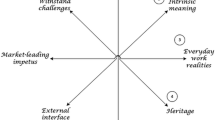Abstract
The optimal design of the message, elements, signals and assessment (MESA) of the brand is central to brand success. Starting from a clearly defined, distinct message (identity) of the brand, which is determined on the basis of the CORE criteria and converted into a brand profile, suitable primary and secondary brand elements can then be selected and (further) developed over time. The different brand elements can be combined into four types of multisensual brand signals: products, environments, media and people (PEMP). Based on this, brand awareness and the brand image anchored in the minds of customers must be continuously recorded. As a result, the four-stage MESA approach ensures that companies identify high-profile brand values for their brands and effectively stage them multi-sensually in order to inspire employees and customers alike and get them interested in the brand(s).
Access this chapter
Tax calculation will be finalised at checkout
Purchases are for personal use only
Similar content being viewed by others
References
Aaker DA (2011) Brand relevance. Making competitors irrelevant. Jossey-Bass, San Francisco
Ackerman JM, Nocera CC, Bargh JA (2010) Incidental haptic sensations influence social judgments and decisions. Science 328:1712–1715
Baumgarth C (2014) Markenpolitik. Markentheorien, Markenwirkungen, Markenführung, Markencontrolling, Markenkontexte, 4. Aufl. Springer Gabler, Wiesbaden
Brandmeyer K, Pirck P, Pogoda A, Prill C (2008) Marken stark machen. Wiley-VCH, Weinheim
Brandtner M (2005) Brandtner on Branding. Styria, Gratkorn
Diffferent and MetaDesign (2006) 5-Sense-Branding. Multisensorische Markenführung mit der 5-Sense-Branding-Box. Unternehmensbroschüre, März
Ecco (2013) Unternehmenswerte – hohle Phrasen oder gelebte Realität? https://www.ecco-network.de/resources/Corporate_Values/Kurzbericht_Deutschland.pdf. Accessed 28 Mai 2020
Görg U (2005) Claims Claiming als Wertschöpfungsinstrument der Markenführung. Gabal, Offenbach
Institute Corporate Senses (2010) Multisensory. Unternehmensbroschüre
Kahn BE (2013) Global brand power. Wharton Digital Press, Philadelphia
Kilian K (2006) So selten wie Sternschnuppen. Die Suche nach einem genialen Markennamen ist nicht einfach. Frankfurter Allgemeine Zeitung, 6. September:B4
Kilian K (2007) Multisensuales Markendesign als Basis ganzheitlicher Markenkommunikation. In: Florack A, Scarabis M, Primosch E (Hrsg) Psychologie der Markenführung. Vahlen, München, pp 323–356
Kilian K (2008) Vertikalisierung der Markenhersteller als Basis inszenierter Markenerlebnisse. In: Meyer H (Hrsg) Marken-Management 2008/2009. Jahrbuch für Strategie und Praxis der Markenführung. Deutscher Fachverlag, Frankfurt a. M., pp 181–205
Kilian K (2009a) From brand identity to audio branding. In: Bronner K, Hirt R (Hrsg) Audio branding brands, sounds and communication. Fischer, Baden-Baden, pp 35–48
Kilian K (2009b) Acoustics as resonant element of mult-sensory brand communication. In: Bronner K, Hirt R (Hrsg) Audio branding brands, sounds and communication. Fischer, Baden-Baden, pp 149–161
Kilian K (2009c) So bringen Sie Ihre Marke auf Kurs. Absatzwirtschaft 52(4):42–43
Kilian K (2010a) Multisensuales Marketing, Marken mit allen Sinnen erlebbar machen. Transfer, Werbeforschung & Praxis 56(4):42–48
Kilian K (2010b) The sound of success – how to keep a brand orchestra in tune with Its MARKnum Opus. In: Bronner K, Hirt R, Ringe C (Hrsg) Audio branding academy yearbook 2009/2010. Nomos, Baden-Baden, pp 37–56
Kilian K (2011) Determinanten der Markenpersönlichkeit. Relevante Einflussgrößen und mögliche Transfereffekte. Gabler Research, Wiesbaden
Kilian K (2012a) Stimmige visuelle Kommunikation gibt Marken ihre Form und Farbe. Media Spectrum 3:20–21
Kilian K (2012b) Markenwerte, welche Markenwerte? Markenartikel 7(5):64–66
Kilian K (2017) Material macht Marken. Form Design Magazine 274:(November/Dezember)112–117
Kilian K (2018a) BEST of Branding für Start-ups. In: Kochhan C, Könecke T, Schunk H (Hrsg) Marken und Start-ups. Springer Gabler, Wiesbaden, pp 55–84
Kilian K (2018b) Markenidentitäten und Imagetransfers optimal gestalten. In: Kilian K, Pickenpack N (Hrsg) Mehr Erfolg mit Markenkooperationen. BusinessVillage, Göttingen, pp 35–53
Kilian K (2018c) Multisensualität in der Kommunikation wirkungsvoll gestalten. In: Langer T, Esch F-R, Bruhn M (Hrsg) Handbuch Techniken der Kommunikation. Springer Gabler, Wiesbaden, pp 119–139
Kilian K (2020a) Influencer-Marketing. In: Stumpf M (Hrsg) Die 10 wichtigsten Zukunftsthemen im Marketing, 2. Aufl. Haufe Group, Freiburg, pp 70–105
Kilian K (2020b) Wie Farben und Formen, Schriften und Schlüsselbilder sowie Materialien und Marken prägen können. Transfer – Zeitschrift für Kommunikation und Markenmanagement 66(2):36–42
Kilian K, Keysser V (2017) Markenwerte der 110 führenden deutschen Unternehmen im Vergleich. Unpublished Working Paper, University of Applied Sciences Würzburg-Schweinfurt. Würzburg
Kilian K, Pickenpack N (2018) Mehr Erfolg mit Markenkooperationen. Partnerschaften im Zeitalter der Digitalisierung. BusinessVillage, Göttingen
Kleiner and Bold (2011) Wer bin ich? Unternehmenswerte im Mittelstand auf dem Prüfstand. Markt und Mittelstand-Research, Frankfurt a. M.
Klepper K (2010) Wie schmeckt Glück, wie riecht Kompetenz, wie klingt Beständigkeit?, (Vortrag auf dem 1. Forum für Multisensorisches Marketing am 15. September in Essen)
Kroeber-Riel W (1988) Kommunikation im Zeitalter der Informationsüberlastung. Mark ZFP 10(3):182–189
Küthe E, Küthe F (2002) Marketing mit Farben. Gabler, Wiesbaden
Linxweiler R (2004) Marken-Design, 2nd edn. Gabler, Wiesbaden
Meyer T (2007) Markenscorecards. VDM, Saarbrücken
Müller E, Rest J (2018) Markenkiller Alexa. Manager-Magazin 7:78–86
Perrey J, Meyer T (2011) Mega-Macht Marke. Erfolg messen, machen, managen, 3. Aufl. Redline, München
Reichheld FF (2003) The one number you need to grow. Harv Bus Rev 81:46–54
Ries A, Trout J (2001) Positioning the battle for your mind. McGraw-Hill, New York
Scheier C, Held D (2014) Die Neuro-Logik erfolgreicher Markenkommunikation. In: Häusel HG (Hrsg) Neuromarketing. Erkenntnisse der Gehirnforschung für Markenführung, Werbung und Verkauf, 3. Aufl. Haufe, München, pp 77–114
Schmidt HJ (2015) Markenführung. Springer Gabler, Wiesbaden
Serviceplan and Facit (2007) Hippness bringt keine Erfolgsgarantie. Horizont 43:50
Williams LE, Bargh JA (2008) Experiencing physical warmth promotes interpersonal warmth. Science 322:606–607
Author information
Authors and Affiliations
Corresponding author
Editor information
Editors and Affiliations
Rights and permissions
Copyright information
© 2023 The Author(s), under exclusive license to Springer Fachmedien Wiesbaden GmbH, part of Springer Nature
About this chapter
Cite this chapter
Kilian, K. (2023). Identifying Brand Values and Staging Them Multisensually. In: Mau, G., Schweizer, M., Oriet, C. (eds) Multisensory in Stationary Retail. Springer, Wiesbaden. https://doi.org/10.1007/978-3-658-38227-8_6
Download citation
DOI: https://doi.org/10.1007/978-3-658-38227-8_6
Published:
Publisher Name: Springer, Wiesbaden
Print ISBN: 978-3-658-38226-1
Online ISBN: 978-3-658-38227-8
eBook Packages: Business and ManagementBusiness and Management (R0)




